|  |
|
How to Get Squirrels Out of Your Attic
A very common wildlife problem occurs when squirrels invade a home, in particular, the attic. They can also live simply in the eaves or soffits, anywhere above a ceiling, or in the walls. The principles discussed below
work for any such case. The squirrel in question is the Eastern Gray Squirrel, which is very common nationwide.
If you don't live in FL, click here for my
National Directory of Wildlife Trappers servicing 98% of the USA population.
First of all, it might help to know why squirrels are there.
The first answer is that your attic makes great squirrel habitat - it's dry, warm, and safe, like a big hollow tree. But most of the time, the squirrels in
your attic are actually a female squirrel and a litter of 3-5 young. In the below photos you can see various squirrels in attics. First, a lone
squirrel, then a a family of several squirrels, then a nest of 3 baby squirrels, and finally, a squirrel poking its head out of a flimsy soffit screen, which it
used to gain access to the attic.
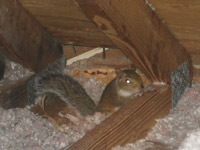


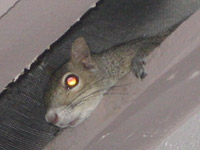
So you want to know how to get squirrels out of your attic. It's not always a simple task - it often requires 1) physical removal of baby squirrels in a nest
in an attic or down the walls,
2) (humane) trapping or exclusion of adult squirrels with special mounted traps on the entry holes or roof, 3) repairs to the entry points all over the house, with steel, and 4) cleanup of waste
and repair of damage to wood and wires. The following tips and info should help in the squirrel removal process.
First of all, you have to determine if there's baby squirrels. Squirrels have two litters per year. For a 6-week span in August to
mid-September, there's baby squirrels. After that time frame, the young are running about like mama squirrel, and suddenly the noise increases a great deal.
In fact, this is when many people notice the squirrels in the first place. The same goes for the winter litter, from February to mid-March (these time
frames can vary a bit in different areas of the country). If you see only one squirrel, it's a good bet that it's a female, and there's a nest of baby
squirrels in the attic or walls, as seen in the above photo. If so, you must find and remove them by hand, or else they will die and rot and stink, or
if big enough, chew the crap out of your attic if stuck inside without their mother. That's why it's a bad idea to simply set some traps outside.
I like one-way exclusion doors, with which you don't have to trap at all, but there are many cases in which trapping is the best answer. But there are several different
types of traps for different situations. Read my How to Trap Squirrels guide for more detailed info on trap types, where and
how to set them, bait, etc.
Click the below photographs for examples of how to properly trap squirrels in the attic:
The best way to make sure you solve your squirrel problem is to find out how they are getting into the house and attic in the first place. When people
ask me how to get squirrels out of your house, I tell them that they must to a full inspection of the whole house, top-to-bottom, and find out how the
squirrels got in. Then you can mount traps on the hole, as seen in the first photo below. In the photo all the way to the right, you can see
that I've mounted one of these special traps on a vent, which the squirrel was using for access. When it goes outside to get food and water, it gets
caught (squirrels go in and out several times a day, by the way - they need to eat and drink). In the second photo, we see a one-way exclusion door.
That allows them to get back out, but not back in. This works well of there's no way to chew wood to get back in. Of course, you can always set
traps to catch them in cages, such as seen below, me with several squirrels. Trapping is an art - just the right location (on the roof) with just the
right trap (bought at a professional supplier) and the right pan settings and bait and such.
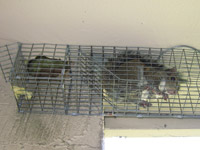

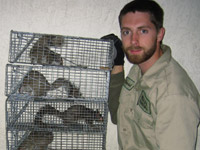
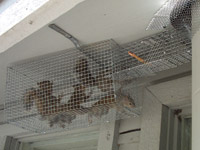
You could also just let them be, and see if they will go away on their own. I definitely DO NOT recommend this. First of all, they will just come back in soon for the next
litter, and it will go on for years, I promise you that. While in the attic, they can cause a lot of damage. They are rodents, and so they chew
a lot. They often chew on electrical wires, which can cause electric outages and fire hazards. Yes, squirrels can burn your house down.
They also chew on wood, sometimes right through beams. They also spread a lot of poop and urine, and various zoonotic diseases and parasites.
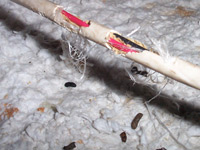
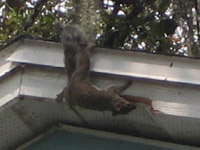
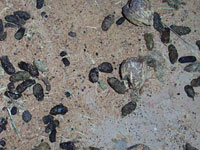
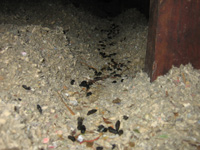
My honest opinion is that you call a professional. I'm not just saying that to endorse my line of work, but because I constantly observe cases in
which a homeowner decided to get rid of squirrels in the house themselves, and just created several bigger problems. A family of squirrels in the
house, attic, or walls is a complex case with many variable, and usually only an experienced wildlife professional can get the job done right. So for
the question of how do you get squirrels out of your attic, I definitely recommend that you hire a pro. I have a list of several hundred wildlife control professionals
nationwide, so you can call someone in your area to talk about your squirrel problem if you wish.
The principles for how to get squirrels out of your walls, or how to get squirrels out of your house, anywhere, from the soffits to the eaves or ceiling, are the same as for the attic. Find
the entry points, make sure the young are removed, fix all secondary entry areas, mount traps on the main hole, repair damages.

 |
PHOTOS: For great pictures of squirrel trapping and removal, click on my: Squirrel Photographs gallery. |
Here is a complete list of my other squirrel control pages:
Baby Squirrels in the Wall
Squirrel in the Chimney
How to Get Rid of Squirrels in the Attic
Squirrels Chew on Your Home
Squirrel Control
How to Get a Squirrel Out of the Wall
How to Get Rid of Squirrels
How to Keep Squirrels Away from House
How to Kill Squirrels
How to Catch a Squirrel
It Is Difficult To Find How Squirrels Are Getting In -
A lot of people think that it is difficult to find how squirrels are getting into the house, but it is not as bad as you may think. You will have to do some work however so that you can find the exact location. Sometimes it may feel as if you have found the entry point, but just because there is a hole in the wall does not mean that the squirrel has access through it. There may be a beam right behind the wall, and that would stop the squirrels from getting in, so make sure that you look at the actual hole that you have found.
You should first do a walk-around your home making sure that you pay special attention to the space where the wall meets the roof, and the basement. The entry point may be behind vegetation so try to get there as much as possible. When you do find the entry point you should plug the hole with something that the squirrels will not chew through. That means that you can use metal and even tin foil will work as long as you bunch it up. So if you think that it is difficult to find how squirrels are getting in then perhaps these tips will help you get started.
| |
|